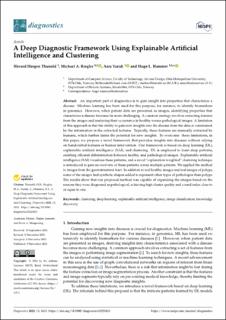| dc.description.abstract | An important part of diagnostics is to gain insight into properties that characterize a
disease. Machine learning has been used for this purpose, for instance, to identify biomarkers
in genomics. However, when patient data are presented as images, identifying properties that
characterize a disease becomes far more challenging. A common strategy involves extracting features
from the images and analyzing their occurrence in healthy versus pathological images. A limitation
of this approach is that the ability to gain new insights into the disease from the data is constrained
by the information in the extracted features. Typically, these features are manually extracted by
humans, which further limits the potential for new insights. To overcome these limitations, in
this paper, we propose a novel framework that provides insights into diseases without relying
on handcrafted features or human intervention. Our framework is based on deep learning (DL),
explainable artificial intelligence (XAI), and clustering. DL is employed to learn deep patterns,
enabling efficient differentiation between healthy and pathological images. Explainable artificial
intelligence (XAI) visualizes these patterns, and a novel “explanation-weighted” clustering technique
is introduced to gain an overview of these patterns across multiple patients. We applied the method
to images from the gastrointestinal tract. In addition to real healthy images and real images of polyps,
some of the images had synthetic shapes added to represent other types of pathologies than polyps.
The results show that our proposed method was capable of organizing the images based on the
reasons they were diagnosed as pathological, achieving high cluster quality and a rand index close to
or equal to one. | en_US |

